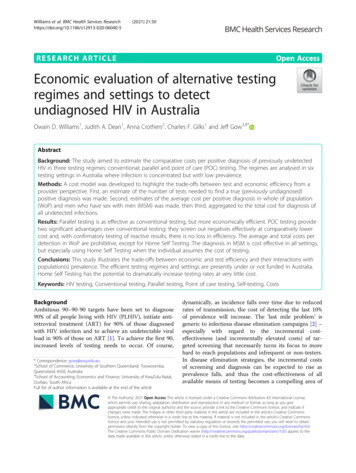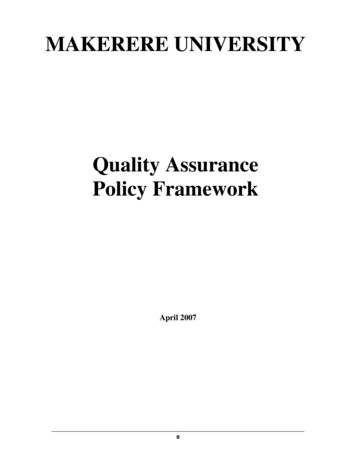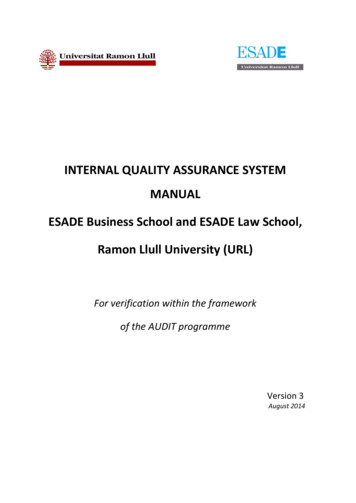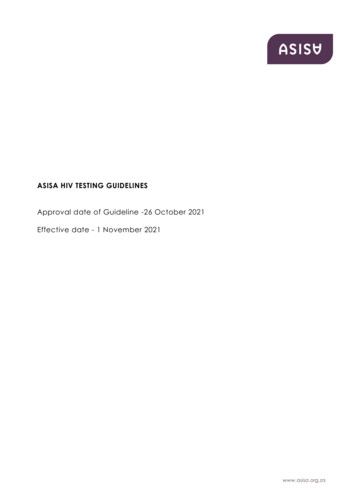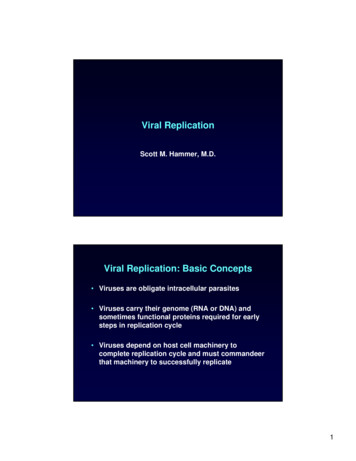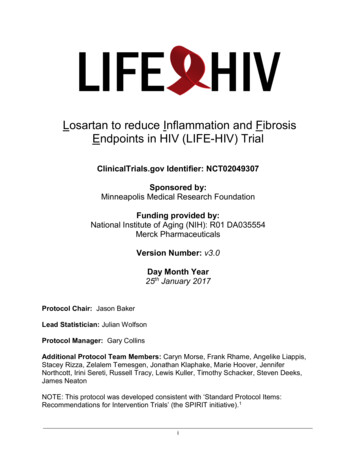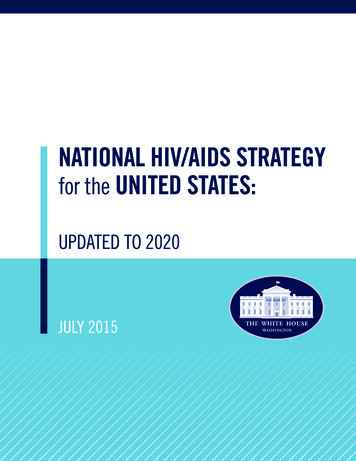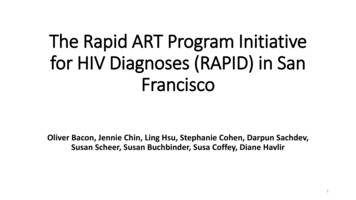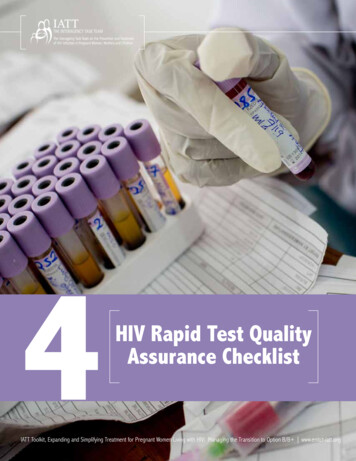
Transcription
4HIV Rapid Test Quality Assurance Checklist4HIV Rapid Test QualityAssurance ChecklistIATT Toolkit, Expanding and Simplifying Treatment for Pregnant Women Living with HIV: Managing the Transition to Option B/B www.emtct-iatt.org81
4HIV Rapid Test Quality Assurance Checklist4.1 BackgroundThe past decade has seen a rapid global scale-up of HIV testing and counselling (HTC),the vast majority using HIV rapid tests (HIV RT). The relative simplicity of HIV RTs hasexpanded the accessibility of HIV testing in areas with limited laboratory facilities andno formal laboratory trained staff, thereby significantly increasing the number of personswho learn their HIV status. As the provision of antiretroviral therapy (ART) for all pregnantand breastfeeding women and for all children 5 years of age is scaled-up, there is anincreased need to ensure the quality of HIV rapid testing and address common servicedelivery issues regarding HIV testing in maternal, newborn and child health (MNCH) clinics.4.2 Purpose and Intended Use of the ToolThe purpose of this checklist is to facilitate the process of thinking through key HIV RTquality assurance (QA)1 and programmatic issues needed to improve HIV rapid testing inMNCH settings. This document expands upon the Option B/B Readiness AssessmentChecklist and offers more detailed recommendations on specific HIV testing activities.4.3 AudienceHIV Rapid Test Quality Assurance ChecklistThis checklist will be useful for public health authorities, programme managers and laboratory technicians at the central, regional and district levels when planning for and establishing minimum standards and requirements for the quality assurance of HIV rapid testing in MNCH programmes.82
44.4 IntroductionThe World Health Organization 2013 Consolidated Guidelines on the Use of Antiretroviralsfor the Treatment and Prevention of HIV Infection recommended the provision of ART forall HIV-positive children 5 years of age and for pregnant and breastfeeding women livingwith HIV. Consequently, ART initiation is based solely on the result of the HIV RT for pregnant and breastfeeding women and for children 18 months – 5 years of age (children 18months have PCR as their diagnostic HIV test). Misclassification (false positive or falsenegative) of HIV RTs can occur due to inherent limitations of the HIV RT, use of expiredtest kits, deviation from the national testing algorithm, (including a screening test, confirmatory test and tiebreaker), or any deviation from the HIV RT standard operating procedure. Responsible programming demands the implementation of QA systems to ensurethe accuracy of HIV test results. In particular, it is important that HIV-negative women andchildren are not mistakenly initiated on lifelong ART, and that women and children livingwith HIV do not miss PMTCT and ART treatment opportunities due to misdiagnosis.The following areas need to be addressed to assure the quality of HIV RTs: 1) a nationalpolicy for HIV RT QA; 2) standardized HIV RT training and national certification programmefor testers;2 3) the regular use and review of a standardized HIV RT QA logbook;3 4) theimplementation of a national HIV RT proficiency testing programme;4, 5 and 5) the routineuse of quality control (QC) samples. It is critical that all MNCH sites adopt these policyand QA activities to ensure the accuracy of HIV test results.HIV Rapid Test Quality Assurance Checklist83
4HIV Rapid Test Quality Assurance Checklist for MNCH SettingsKey:Before implementationEarly in implementationPOLICY ENGAGEMENTDuring implementationCompleted In Process Not yet startedNational guidelines for laboratory quality assurance in HIV rapid testing (including proficiencytesting and the use of a standardized HIV RT QA logbook)Costing and budget allocation for QA activitiesNational technical working group (TWG) inclusive of stakeholders from MNCH, PMTCT, HIVtreatment and laboratory to review HIV testing strategies and ensure the national HIV testingalgorithm follows WHO guidanceImplement mechanisms to address rapid test kit stock-outs, expired test kits and recallsPolicy decision on the treatment of discordant couplesInclude RT QA monitoring in all site supervision visitsTRAINING AND CERTIFICATIONCompleted In Process Not yet startedNational policy requiring training, periodic re-training and certification of HIV testing personnelHIV testing training curricula incorporated into all pre-service and in-service ART andPMTCT trainings and including the use and analysis of standardized QA logbooks andproficiency testingUSE OF STANDARDIZED LOG BOOKCompleted In Process Not yet startedStandardized HIV logbook or register used to capture key HIV testing data(e.g., kit names, lot #, expiration dates, and result of each test in the algorithm)aHIV testing logbooks or registers harmonized across programmes and used at all sites(e.g., HTC, PMTCT, inpatient, etc.)Ensure that clinical site staff and site supervisors review standardized logbook data andperform corrective actions as neededPROFICIENCY TESTING AND QUALITY CONTROLCompleted In Process Not yet startedProficiency testing (PT) and quality control (QC) programme is in place to monitor thecompetency of all testing personnel and sites with dried tube specimens (DTS) or plasmaPT programme data are used to provide timely feedback and corrective actions to thetesting sitesSERVICE DELIVERYStrategy for repeat testing during pregnancy/labour and delivery and during the breastfeedingperiod developed and implementedStrategy for HIV testing for older children of HIV-positive pregnant and breastfeeding womendeveloped and implementedPartner testing and disclosure assistance services available for all pregnant andbreastfeeding womenStrategy to provide ART to HIV-positive male partners developed and implementedHIV Rapid Test Quality Assurance ChecklistImplementing universal HIV screening at immunization clinics in high-burden settings84aRevision of existing registers to include key HIV RT QA elements is an acceptable alternative.Completed In Process Not yet started
4Resources1 Parekh, Bharat S., et al., ‘Scaling Up HIV Rapid Testing in Developing Countries: Comprehensiveapproach for implementing quality assurance’, American Journal of Clinical Patholology, vol. 134, no. 4,October 2010, pp. 573–584.2 World Health Organization, ‘Guidelines for Assuring the Accuracy and Reliability of HIV Rapid Testing: Applying a quality system approach’, WHO, Geneva, 2005, available at 563 eng.pdf?ua 1 .3 World Health Organization, ‘A Handbook for Assuring and Improving HIV Testing and CounsellingServices: Field-test version’, WHO, Geneva, 2010, available at 500463 eng.pdf?ua 1 .4 Parekh, Bharat S., et al., ‘Dried Tube Specimens: A simple and cost-effective method for preparation of HIV proficiency testing panels and quality control materials for use in resource-limited settings’,Journal of Virological Methods, February 2010, vol. 163, no. 2, pp. 295–300.5 Benzaken, Adele Schwartz, et al., ‘External Quality Assurance with Dried Tube Specimens (DTS) forPoint-of-Care Syphilis and HIV Tests: Experience in an indigenous populations screening programme inthe Brazilian Amazon’, Sexually Transmitted Infections, vol. 90, no. 1, February 2014, pp. 14–18.Point of Contacts: Helen Dale, Centers for Disease Control and Prevention, Division ofGlobal HIV/AIDS, ffg4@cdc.gov; Joy Chang Centers for Disease Control and Prevention,Division of Global HIV/AIDS, ckc7@cdc.gov; and Anisa Ghadrshenas, Clinton HealthAccess Initiative, aghadrshenas@clintonhealthaccess.orgHIV Rapid Test Quality Assurance Checklist85
HIV Rapid Test Quality Assurance Checklist 4 83 4.4 Introduction The World Health Organization 2013 Consolidated Guidelines on the Use of Antiretrovirals for the Treatment and Prevention of HIV Infection recommended the provision of ART for all HIV-positive children 5 years of age and for pregnant and breastfeeding women living
